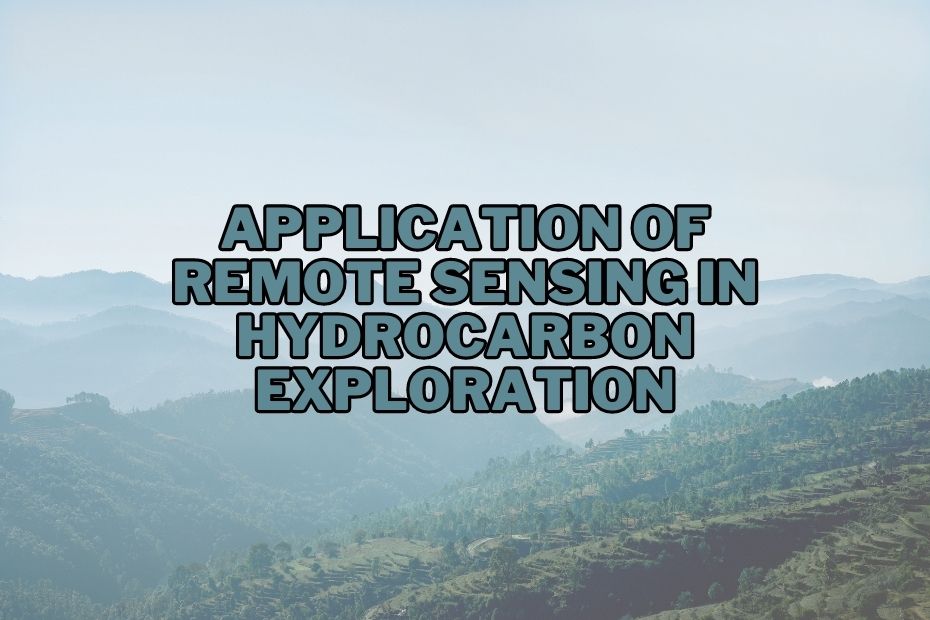The application of remote sensing in hydrocarbon exploration has transformed the oil and gas industry, revolutionizing how we discover and extract these valuable resources. Remote sensing techniques, utilizing satellites, drones, and other advanced technologies, offer a wide range of benefits that have significantly improved exploration efficiency and environmental sustainability.
Remote sensing aids in identifying potential drilling locations, monitoring pipeline integrity, assessing environmental impacts, and estimating hydrocarbon reserves, among other applications.
Application of Remote Sensing In Hydrocarbon Exploration
Would you believe if we told you that satellites high above our planet are helping us find resources buried deep beneath the earth’s surface? It’s like using a telescope to find a needle in a haystack, isn’t it? Let’s see how.
1. Identification of Oil and Gas Seeps
One of the essential application of remote sensing in hydrocarbon exploration is the identification of oil and gas seeps. These natural seeps release hydrocarbons to the surface, indicating potential reservoirs beneath. By analyzing satellite images and hyperspectral data, remote sensing allows us to locate these seeps accurately. This information is vital for prospecting and prioritizing exploration areas.
2. Geological Mapping
Remote sensing facilitates detailed geological mapping over vast and inaccessible regions. By integrating multispectral and radar data, geologists can identify different rock types, geological structures, and sedimentary basins. This aids in comprehending the subsurface geology and identifying potential hydrocarbon traps.
3. Vegetation Analysis
Vegetation analysis is another valuable application of remote sensing in hydrocarbon exploration. Healthy vegetation is indicative of underground water sources, which are often associated with oil and gas reservoirs. Remote sensing data assists in identifying areas with lush vegetation, helping exploration teams focus on prospective regions.
4. Pipeline Monitoring
Once hydrocarbon reserves are discovered and extraction begins, monitoring pipelines becomes crucial. Remote sensing technologies, such as synthetic aperture radar (SAR), can detect ground subsidence or deformation, which may indicate potential pipeline leaks or structural issues.
5. Offshore Platform Siting
Before establishing offshore drilling platforms, comprehensive site selection is necessary to ensure maximum productivity and minimal environmental impact. Remote sensing aids in assessing seabed topography, currents, and marine life distribution, streamlining the platform siting process.
6. Seismic Hazard Assessment
Hydrocarbon exploration often involves seismic surveys to identify subsurface structures. Remote sensing data enhances these surveys by providing information on earthquake-prone regions, potential landslides, or other geohazards that might affect seismic operations.
7. Gas Flaring Monitoring
During oil extraction, flaring of associated gas is a common practice. Remote sensing technologies can monitor and quantify gas flaring activities, providing valuable data to optimize production processes and minimize environmental impacts.
8. Soil Analysis
Remote sensing enables soil analysis for identifying areas with high organic content, which can indicate the presence of hydrocarbons. By studying soil moisture, vegetation patterns, and thermal infrared data, exploration teams can narrow down potential drilling locations.
9. Thermal Anomaly Detection
Hydrocarbons often emit thermal signatures that can be detected by remote sensing infrared sensors. These thermal anomalies help pinpoint potential reservoirs, especially in areas with challenging surface conditions.
10. Environmental Monitoring
Remote sensing plays a vital role in monitoring the environmental impacts of hydrocarbon exploration and production. From tracking deforestation caused by infrastructure development to assessing water quality near drilling sites, remote sensing helps ensure responsible and sustainable practices.
11. Reserve Estimation
Once hydrocarbon reserves are discovered, estimating their size and volume is crucial for efficient production planning. Remote sensing data, combined with geological data and well performance analysis, aids in accurately estimating hydrocarbon reserves.
12. Safety and Security
Incorporating remote sensing technologies enhances safety and security measures during hydrocarbon exploration and production operations. Monitoring potential hazards, pipeline leaks, or unauthorized activities becomes more efficient with real-time remote sensing data.
Conclusion
Remote sensing has revolutionized the hydrocarbon exploration industry by providing invaluable data and insights. From identifying oil and gas seeps to estimating reserves and ensuring safety, its applications are diverse and far-reaching. Embracing this technology is vital for optimizing exploration efforts, promoting sustainability, and mitigating environmental impacts.
FAQs: Application of Remote Sensing In Hydrocarbon Exploration
Can remote sensing replace traditional exploration techniques entirely?
While remote sensing offers powerful tools for exploration, it complements rather than replaces traditional techniques like seismic surveys and well drilling. Integrating these methods yields more comprehensive results.
How does vegetation analysis aid in hydrocarbon exploration?
Vegetation analysis helps identify areas with potential hydrocarbon reserves by highlighting regions with abundant vegetation, often indicative of underground water sources associated with oil and gas deposits.
What role does remote sensing play in pipeline monitoring?
Remote sensing, particularly SAR, can detect ground subsidence or deformation, which may indicate pipeline leaks or structural issues, enabling timely maintenance.
How does thermal anomaly detection work in hydrocarbon exploration?
Remote sensing infrared sensors detect thermal signatures emitted by hydrocarbons, helping identify potential reservoirs based on temperature anomalies.
How does remote sensing assist in geological mapping?
It employs advanced technologies like radar and LiDAR to map surface and subsurface formations, aiding in the discovery of petroleum and natural gas deposits.
